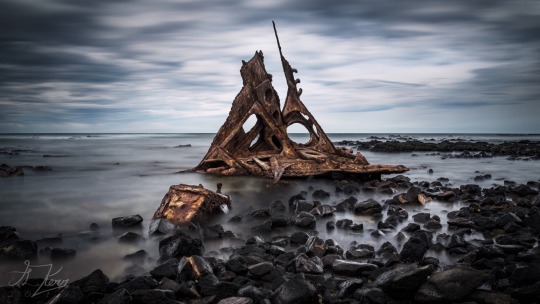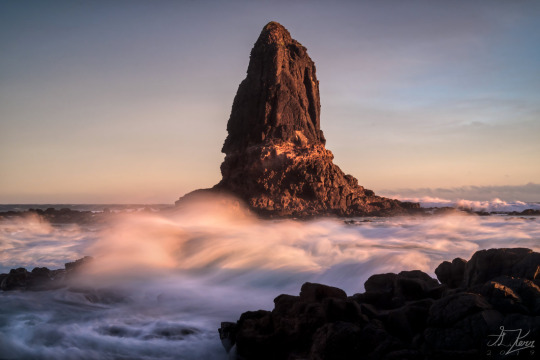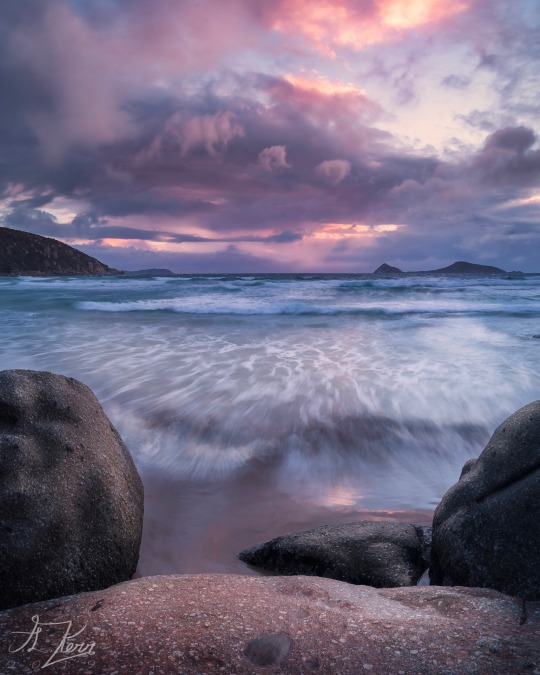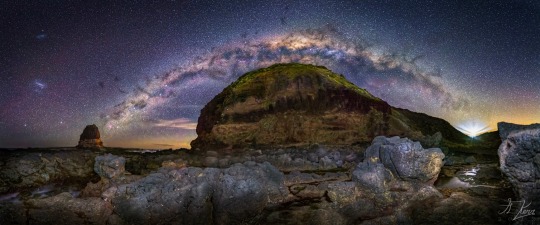Text

“Ruin”
Shot from Victoria’s Phillip Island a few years ago, this long exposure photograph depicts the passage of time with the remnants of SS Speke. SS Speke was a sail-powered, steel-hulled cargo ship which ran aground in November 1905. This is part of the bow section and many pieces of the ship can be found along the southern coastline around Kitty Miller Bay at Phillip Island. I had been wanting to visit this location for a while after seeing many photos of this famous shipwreck. I chose to photograph this with a long exposure to soften the water movement and capture the movement in the clouds. The photo was then processed to dull most of the colours, leaving behind the orange and brown tones of the rusty steel structure. This isn’t how I’d usually process my photographs as I tend to like high contrast and vivid colours in my photographs. The subject and theme of this photograph really suits the processing I’ve done on it - desaturated colours and softer tones, contrasting against the brown structure, dark and rugged rocks. The rocks which, ultimately, brought an end to SS Speke’s service.
#Opticus Photography#Nikon D750#Long Exposure Photography#Seascape#Shipwreck#SS Speke#Visit Victoria#Phillip Island#Australia
14 notes
·
View notes
Text

“Silk”
Cape Schanck in Victoria, Australia is a wonderful place. There are so many things to photograph. One evening I was out there, there was a magical sunset glistening over the rough waters. The use of a long exposure allowed me to smooth out the rough seas to create what looks like clouds with Pulpit Rock sticking out through them. The way the light hits the rocks and the water is what made me want to photograph this and I thought I’d be able to get a cool effect by using a slower shutter speed to blur the motion of the waves.
#Opticus Photography#Nikon D750#Long Exposure Photography#Seascape#Cape Schanck#Visit Victoria#Australia
4 notes
·
View notes
Text

Lunar eclipse at partial umbral stage. Here you’ll notice three distinct regions of light. Up the top is the portion of the moon under penumbral shadow (the outer part of the shadow). The blue region is on the edge of the umbral shadow (the inner, darker part of a shadow cast by an object) and the red is in the umbral part of the shadow. When the whole moon goes into the umbral shadow, that is when a lunar eclipse is said to have gone into totality. The different colours are caused by refraction - light bending as it passes through Earth’s atmosphere. The red portion is because red light bends the most, so it is seen over most of the umbral shadow. The blue portion is caused by light just grazing through Earth’s upper atmosphere where it is not refracted as much or filtered out by atmospheric dust, haze and aerosol particles - most of which are at much higher concentrations in the lower atmosphere.
8 notes
·
View notes
Text

The lunar eclipse in totality against the backdrop of Scorpius. Although I did get some close up shots of the moon I wanted to shoot a photo of the moon in this position. Scorpius is one of the most recognisable constellations in the Southern Hemisphere night sky and for the moon to be in this position during the eclipse I thought was pretty awesome.
6 notes
·
View notes
Text

“Encumberance” - Mock up
‘Every moment they feel vupnerable while carrying their own massive burdens. Emotional storms raging in their heads. They feel isolated - in constant darkness and turmoil, constantly reflecting on traumatic experiences. Every day they have the blues, and the only thing holding them together are the rock-solid constants in their lives.’
This is a mock-up image of my artistic interpretation of depression and anxiety. Mental illnesses which aren’t taken seriously enough at times which cost the lives of many teens and adults alike.
2 notes
·
View notes
Text

Haven’t posted for a while so now I welcome myself back. Anyway, a bit of a backstory about me, I’m a New Zealand-born hobbyist landscape photographer living in Melbourne, Australia. I’ve been an avid photographer for the last three years. I’m an aluminium window fabricator by trade but try to get out on weekends to pursue my landscape photography hobby. Art has always been a passion of mine but wasn’t until somewhat recently that I picked up a camera and started taking photos. My passion for photography exploded after clicking that shutter for the first few times.
I hope everyone has been doing well and coping over the covid-19 pandemic. Stay safe everyone.
29 notes
·
View notes
Text

“The Cleansing”
Wilson’s Promontory National Park, located around 3.5 hours drive from Melbourne, is a stunning paradise of majestic landscapes, amazing coastal views, whole-day and overnight hiking tracks, and towering mountain peaks. It is the only national park I’ve yet to visit which is actively patrolled by park rangers, whom ensure the park is left clean and tidy and its natural beauty preserved for the next lot of visitors. What was planned to be a weekend of pure astrophotography in the park’s Bortle class 1 night sky proved to be a disappointment. The weather took a turn for the worst and despite being forecast to be clear most of my first night there, the clouds rolled in just before sunset and decided to stay put and drop rain for most of the night. Anyway, despite a botched astrophotography session, I was still able to grab a few photos from around the park during the hours of daylight and again the next morning as I ended up cutting my visit short, packing up and going back home.
#Sunset#Beach#Wilsons Promontory#Whiskey Bay#Australia#Long Exposure#Ocean#Seascape#Opticus Photography#Nikon D750
29 notes
·
View notes
Text

“Deep Blue”
The Milky Way rising from Victoria’s Gunnamatta Beach on the Mornington Peninsula in Australia. Gunnamatta Beach is home to some interesting rock formations. Some small rock pools scatter the beach along the ocean’s edge.
#Astrophotography#Milky Way#Space#Stars#Galaxy#Nikon D750#Ocean#Opticus Photography#Gunnamatta Beach#Mornington Peninsula#Victoria#Australia
41 notes
·
View notes
Text
“Leaps and Bounds”
Probably one of my most technical images I’ve captured to date. I kinda fluked this one as I was still very new to both astrophotography and panoramas at the time of capture. This was captured in September 2018 but I re-released the image mid last year. I’m wanting to capture this image again this year but will have to wait ‘til September to do so - the Milky Way doesn’t fall into this position at this location until that time of the year.
“Leaps and Bounds” is one of my greatest accomplishments and greatest technical feats - both in terms of skill behind the camera and skill in the studio: stacking; stitching then processing the final image. This image is made up of 114 seperate exposures, three rows of six frames and each frame is median stacked to reduce digital noise, increase detail and allow for more aggressive post production techniques. Each exposure was shot at f/3.5, ISO 10,000 with a shutter speed of 10 seconds. It took me over an hour to shoot all the exposures required for this image and each exposure was shot at the same location on the same night. First I shot the sky portion of the image, as over time, the stars move through the sky. So I needed to capture the Milky Way before it dipped too far below the hill in the centre of the image. Then, I shot the foreground, using a small torch to illuminate the scene.
When I got home, I had to get all the raw files off the camera, which were then processed in Lightroom on my iPad Pro. After exporting all the ‘pre-processed’ raw files, I then had to stack each frame of the panorama. Stacking is a technique used where multiple images of the same scene are averaged out. The consistent details between each image are enhanced, while randomness (such as digital noise and movement within the frame) are averaged out, resulting in a cleaner looking image. After all the panorama frames were stacked, I then went about stitching the stacked frames together to create the panorama. The stitch was done in two parts. One for the sky as the moving stars are aligned in the stacking process, meaning the foreground effectively blurs (as movement averaged out between frames creates a motion blur). The stitching process of the stacked foreground had a sky which exhibited star trails. So now I needed to blend the two ‘halves’ of the panorama together. This was fiddly and time consuming - masking the sky out of the foreground portion of the panorama took great patience as I had to carefully mask out the sky and preserve the intricate shapes on the ‘edge’ of the foreground portion of the panorama. Then I needed to clone brush out parts of the sky where motion blur from the stacked sky images caused the foreground to creep into the image behind the foreground layer.

#Astrophotography#Stars#Nightscape#Milky Way#Galaxy#Space#Cape Schanck#Mornington Peninsula#Australia#Nikon D750#Panorama#Starbow#Opticus Photography
30 notes
·
View notes
Text

The centre of the Milky Way Galaxy. Shot by me, mid-late last year. Taken from a rural sky - so light pollution wasn’t much of an issue. I can’t remember how many frames I stacked to reduce the appearance of digital noise. Seen in this photograph is Jupiter (the bright ‘star’, mid-upper right). The bright pink part just to the right of centre up the top is the Lagoon Nebula. Most of Scorpius is seen - the tail hooks round from left-centre, goes out of frame, then the body and head of Scorpius come back into frame from the left, angling down toward the bottom right corner.
#Milky Way#Space#Astrophotography#Nikon D750#Stars#Antares#Rho Ophiuchi#Nebula#50 mm f1.8#Galaxy#Jupiter#Opticus Photography
19 notes
·
View notes
Text

Dreamscape I - “Starstruck”
I just love being out on nice nights shooting the stars and interesting landscapes under a starry sky. Just, me, my camera, a couple of warm coffees, a nice landscape, the night sky and the Milky Way. Seeing the Milky Way with my own eyes is always a thrill to me. Watching it slowly move through the sky as the night progresses, seeing the galactic core shine brightly and in some cases, seeing the faint shadows cast solely from starlight. No noisy cities, no city lights, no annoying and/or drunken idiots. Just pure solitude.
44 notes
·
View notes